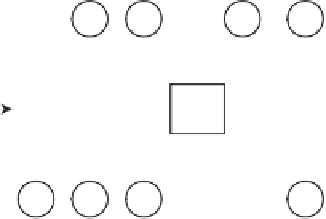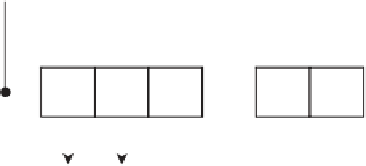Global Positioning System Reference
In-Depth Information
Superframe k
Superfr
am
e k+1
Frame #1
Frame #(i-1)
Frame #i
Frame #(i+1)
Frame #n
Frame #1
Subframe #1
Subframe #j
Subframe #j(j+1)
Subframe #p
UW
CRC
Data field
Tail bits
Computed over
FECencoded then blockinterleaved
Figure 10.7
Navigation message structure.
G
(133 octal)
2
+
+
+
+
Output symbols
(SPS)
Data in
put
(BPS)
(Alternating G /G )
12
Symbol
clock
+++
+
G
(171 octal)
1
Figure 10.8
Convolutional encoder.
where the coefficient on
X
N
is the first transmitted bit of the subframe header and the
coefficient of
x
12
is the last transmitted bit of the navigation data (
N
is the number of
bits in the frame, including the CRC). This polynomial is divided by the generator
polynomial
G
(
x
) using modulo-2 arithmetic. The remainder is a polynomial of
degree 11 in
X
. The first bit of the CRC is the coefficient of
X
11
in this polynomial,
and the last bit of the CRC is the coefficient of
X
0
.
Finally, block interleaving is applied after convolutional encoding to all
subframes, excluding the synchronization pattern. The block interleaver uses block
sizes of
n
k
symbols and fills a
matrix having
k
rows and
n
columns column by column; symbols are then transmit-
ted row by row.
×
k
bits, where a
n
×
k
block interleaver takes
n
×
10.3.3 SAR Signal Plan
The SAR distress messages (from distress-emitting beacons to SAR operators) will
be detected by the GALILEO satellites in the 406-406.1-MHz band and then broad-






















































Search WWH ::

Custom Search